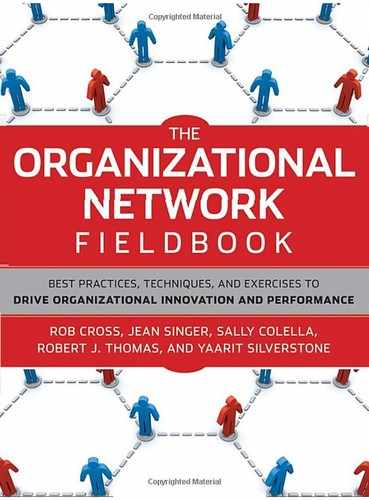12.3. Objective 2: Drive Revenue Growth Through Improved Connectivity
Downing knew that to be sustainable, the changes she made in her unit's networks to improve collaboration had to produce measurable business value in the form of revenue as well as billable hours and client satisfaction and retention. She made several further adjustments to the networks to drive value growth.
12.3.1. Foster Cross-Company Sales Efforts
Downing identified situations in which executives throughout the company were aware of the expertise housed in her unit but didn't see opportunities to collaborate on sales efforts. She asked consultants and executives how they could work together across more parts of the company.
For example, an expert in her unit's Joint Ventures subgroup had worked on several client engagements for the Natural Resources industry group and was called on frequently to participate in client engagements for that group. Though he knew a few executives in the High Tech industry group, he didn't see an immediate opportunity for collaborating with them on client projects. Downing asked him whether the process for organizing, staffing, and governing a joint venture used in the Natural Resources industry could also be useful for a High Tech client. Through a brainstorming session involving Downing, her joint-ventures expert, and key account executives from the High Tech industry group, three new client opportunities were discovered; one of those led to a major new contract for NorthStar three months later.
12.3.2. Make Everyone Responsible for Revenue Generation
Downing also sifted through the company to identify "sweet spot" collaborations—those that had generated sizeable revenue. She analyzed who in her unit had participated in the highest-value collaborations (revenues of $2 million or more) and who had participated in lower-value collaborations (revenues under $250,000). She found that the 10 most-connected people in her unit had participated in collaborations yielding 60 percent of the unit's revenues. The top 5 most-connected people accounted for nearly 40 percent of the unit's revenues. Some of these high earners were well-recognized leaders; others were not. But both types would place the unit's revenues at risk if they were to leave.
To mitigate this risk, Downing set out to make everyone responsible for revenue generation. She asked the high earners to take junior people with them on client calls, so the novices would be trained by the best and could step in if the high performer defected. This action also helped the junior consultants forge more connections throughout the firm as well as learn specifically how to connect with others.
12.3.3. Channel Time Savings into New Revenue
If Downing could increase the number of collaborations that saved her consultants time, she would position those consultants to participate in more revenue-generating projects throughout NorthStar. With this in mind, she asked people in her unit to estimate how much time they saved every month as a result of using information, advice, or other resources received from each other person in the unit. (Responses took forms such as, "When I go to Sara for advice on how to close a sale, I save three days of effort I would have had to put in to get the information I need and to use it.")
The survey revealed that the top 10 people in the unit's advice network (those who were called on most frequently for advice) returned 48 percent of value generated through time savings. The top 5 accounted for 32 percent of the total value.
One person who turned out to play a surprisingly large role in saving time for consultants (and thus freeing them to rack up billable hours) was Pat Stone, the staffing coordinator. Executives from various parts of the company came to Stone when they needed to assemble engagement teams, and consultants came to her when looking for opportunities to be put on a team. Though Stone was relatively low in the unit's hierarchy, her role was essential for saving time: if she became overloaded (which occurred frequently), staffing client engagements took longer. Time was wasted, leading to lower billing, decreased revenue, and lower operating margins.
To guard against this problem in the future, Downing added two support staff to the staffing-coordination office. In addition, she identified the individuals in her unit whose collaborative behaviors helped create the most efficiencies (such as the people who quickly responded to e-mailed or phone requests for documents or information needed in a client engagement). She made these people more visible to others throughout the unit by calling them out in unit conference calls and quarterly all-hands meetings.
